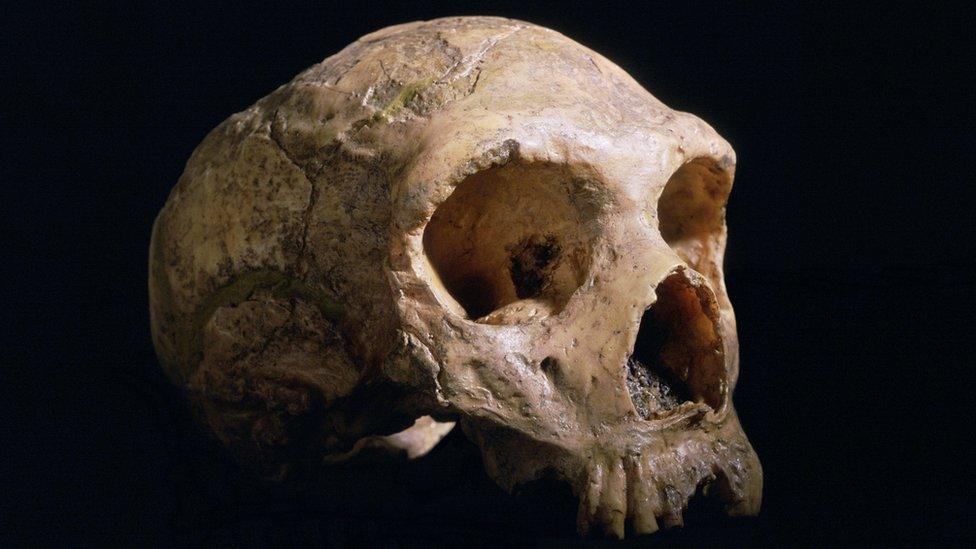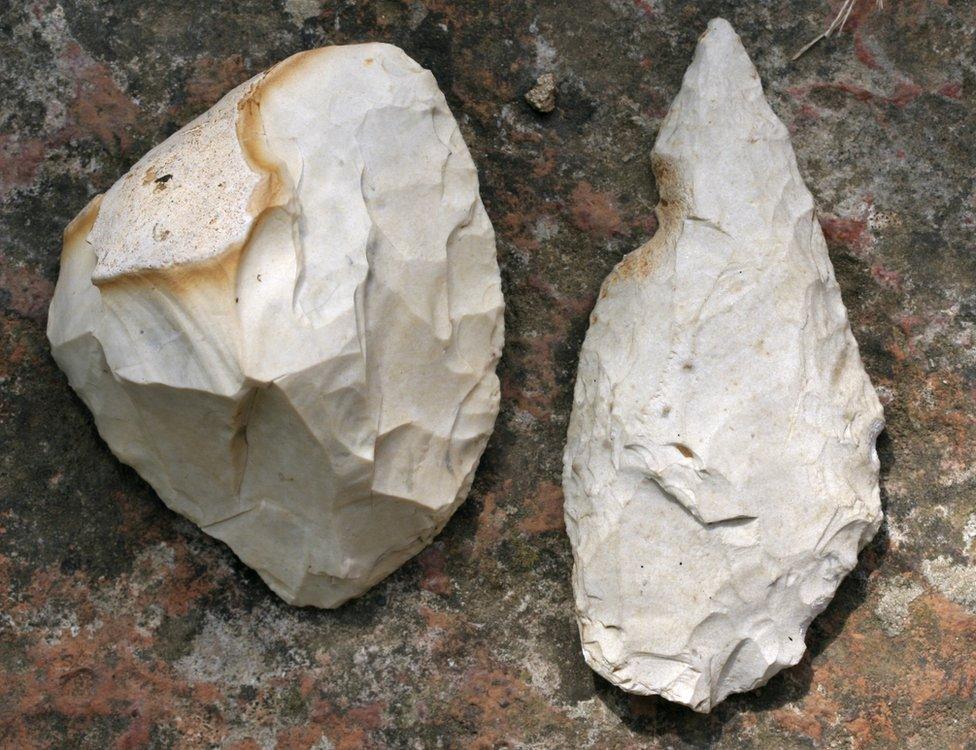Viewpoint: Why we still underestimate the Neanderthals
- Published

Prof Clive Finlayson, director of the Gibraltar Museum, explains why some old assumptions about the intellectual capabilities of our evolutionary relatives, the Neanderthals persist today. But a body of evidence is increasingly forcing us to re-visit these old ideas.
A paper out this week in the journal Nature Ecology and Evolution, external reports the early arrival of modern humans to south-western Iberia around 44,000 years ago.
Why should this be significant? It all has to do with the spread of our ancestors and the extinction of the Neanderthals. South-western Iberia has been claimed to have been a refuge of the Neanderthals, a place where they survived longer than elsewhere, but the evidence is disputed by some researchers.
The latest paper, which is not about Neanderthals, has been taken by some as evidence of an arrival into this area which is much earlier than previously known.
By implication, if modern humans were in south-western Iberia so early then they must have caused the early disappearance of the Neanderthals, external. It is a restatement of the idea that modern human superiority was the cause of the Neanderthal demise. Are these ideas tenable in the light of mounting genetic evidence that our ancestors interbred with the Neanderthals?
You may also have noticed some recent headlines about our Neanderthal heritage and its influence on head shape, external. In particular, a study found that specific DNA sequences seem to be linked to the globular shape of our skulls.
Sequences linked with reduced "globularity" (a measure of roundness) are present in Neanderthals and some living people. The researchers reportedly stressed that the effects of carrying the rare Neanderthal fragments were subtle and could not be detected in a person's head shape when you met them, external. That was reassuring given the current rise of xenophobia and the bad press that Neanderthals have had.
Neanderthals are generally considered to have been a distinct human species (Homo neanderthalensis) that once inhabited a region stretching from Siberia in the east to Iberia in the west, and from Britain in the north to Iraq in the south. They first appear around 450,000 years ago and then die out as our own species starts to settle in Eurasia, after 60,000 years ago. Not everyone agrees that they were separate species.

Neanderthals made these Mousterian stone tools
Discoveries from genetics over the last decade or so reveal that they didn't completely go extinct. Our ancestors (to some defined as the separate species Homo sapiens), mixed with them, so that today, around 2% of the genomes of non-African people alive today is Neanderthal.
We know from a long time back that, although Neanderthals had large brains that may have even exceeded our own in size, their skulls were a different shape from ours. A key element of that difference was that our skulls were indeed more globular.
The suggestion in this recent paper is that skull shape may represent rearrangements in the brain that may reflect differences in the way we think and act. Time will tell if such differences between Neanderthals and ourselves were indeed real and the current paper is just the tip of the iceberg in this exciting and rapidly developing field.
The important question of course, and one which genetics is unlikely to resolve, is to what degree these differences between Neanderthals and ourselves actually had an effect and impact on the ground. In recent years, we have seen how differences in anatomy seem not to have mattered.
These physical differences may have been part of a wider phenotypic diversity within the human population, which included the Neanderthals, and may simply reflect contextual differences in ecology. Anatomy could have constrained some behaviours. For example, the bulky Neanderthals may not have been as suited as our long-distance running ancestors to chasing herds across the mammoth steppe.
Element of surprise
On the other hand, they were probably better than them at ambush hunting large animals at close quarters from cover. In the Pleistocene world of rapidly changing ecological scenarios luck had everything to do with success or failure. It was all about being in the right place at the right time, something that natural selection - with its restriction of acting in the present on templates from the past - could not respond to fast enough.
And so we have consistently mistaken survival and extinction with biological superiority or inferiority. That is why we have incessantly sought differences to explain our observations. We are here and they are not and so we must seek differences to explain the data.
Of course, part of the problem is that we are participants trying to explain a story in which we are actors and that will inevitably lead to bias in our favour. Having given the Neanderthals a name, we immediately conditioned ourselves to seeing them as something else.
They were not us. They were hardly human and we were certainly superior to them. After all, we are here to tell the story. It is one of history's ultimate distortions, perhaps the greatest of them all.

Genomic information from Neanderthals has given us a whole new perspective on our evolutionary relatives
The footnote is that we have to change the chip, the paradigm if you prefer. There is still an insistence on proving that our ancestors took over the planet from all those who had been here before, Neanderthals included. We replaced all and sundry, external.
The evidence of replacement anywhere is, being generous, slim. We have mapped out this replacement, in Europe at least, using the flimsy connection between human type and stone tool technology, external. Stone tools have been used as proxy for expanding populations of humans and declining ones of other humans.
These and other similar connections are based on minuscule associations of remains attributed to human types , external and stone tools, external - in most branches of science the evidence would be dismissed as insignificant. We know that our ancestors and Neanderthals mixed genes, but we have no idea what the hybrids looked like or what kind of tools they made.
We know other human lineages - the Denisovans - from genomes extracted from non-diagnostic bones, external. This means we do not even know what they looked like. And there were "ghost" species that we only pick up from traces left in the genes of descendants.
Yet we persist in the conviction that qualitatively defined stone tool technologies can really map out a complex process that took 10 times longer than the time from the birth of Christ to today.
Denigrating the Neanderthals has been part of that process of exalting our own. In a recent BBC television documentary I was asked if I would like to meet a Neanderthal today.
My immediate response was to say yes, but I hesitated and changed my mind. If our history is anything to go by, what would we do if we found a remotely isolated group of Neanderthals somewhere on Earth today? I leave it to the reader to answer that question.
Professor Clive Finlayson is director, chief scientist and curator of Gibraltar Museum. His latest book - The Smart Neanderthal - will be published in February 2019.
References
1. Miguel Cortes-Sanchez et al. (2019) An early Aurignacian arrival in southwestern Europe. Nature Ecology & Evolution.
2. Katerina Douka. (2019) No hard borders for humans. Nature Ecology & Evolution.
3. Phillip Gunz et al. (2018) Neandertal Introgression Sheds Light on Modern Human Endocranial Globularity. Current Biology,
4. Charles Q Choi. (2018) Do You Carry Neanderthal DNA? The Shape of Your Skull May Tell. Live Science.
5. Clive Finlayson (2009) The Humans Who Went Extinct. Why Neanderthals died out and we survived. Oxford University Press.
6. Jean Jacques Hublin (2017) The last Neanderthal. PNAS 114(40): 10520-22
7. Philip R. Nigst et al. (2014) Early modern human settlement of Europe north of the Alps occurred 43,500 years ago in a cold steppe-type environment. PNAS 111(40): 14394-99
8. S. E. Bailey et al. (2009) Who made the Aurignacian and other early Upper Palaeolithic industries? Journal of Human Evolution 57(1): 11-26; S. Benazzi et al. (2011) The early dispersal of modern humans in Europe and implications for Neanderthal behaviour. Nature.
9. Melissa Hogenboom (2015) How interbreeding shaped us. BBC Earth.
10. Pallab Ghosh (2010) New kind of early human discovered. BBC News; Paul Rincon (2010) DNA identified new ancient human. BBC News.
9. David Reich (2018) Who we are and how we got here. Pantheon Books.
10. Neanderthals: Meet Your Ancestors. BBC Two.